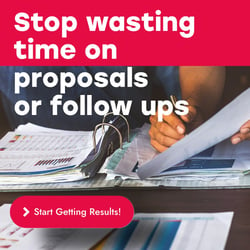B2B Sales: 10 Effective Tips You Can Use to Close More Deals
Closing B2B sales can be challenging and it's becoming more competitive by the day. Especially in an ever evolving, digital world. Plus, the more sales your company need to grow, the more taxing it is on your organization.
Closed another new client? Great! But now you need to service the account. And you probably just spent weeks or months chasing the prospect down in order to get the deal across the finish line. Which means you spent a ton of time, money and resources just to get it to this point. You're starting with this new client in the negative.
Is it really a deal?
That's OK you say. We'll hire more people to service the account. But here's the truth...You need the revenue to keep growing your business, but the time and cost to get the revenue (and then service it) is eating into your margins, and killing your ability to scale.
So what's the real issue here?
YOUR SALES PROCESS IS FLAWED.
You're running moves from a playbook designed by the businesses the came before you. "It's the way it's done", but it's killing you.
But don't worry. There's a better way, and it starts by improving your sales process. It comes down to your ability to accelerate how fast and how easily you can acquire new, ideal prospects and then how efficiently you can convert them into revenue. HOWEVER, it's not just about speed – think about how much time and money it costs you in the time between finding a prospect and actually making a profit?
It's a lot, isn't it?
Well, here's the secret that no one's going to tell you. You need to be profiting from your business development process BEFORE your prospect commits to a large engagement...
What?! But How?!
Well, we'll give 10 tips below that you can use to kick off this process, but let's be serious. This is a blog, not an entire manual or playbook on how to accelerate your sales process. And while we're not selling our tips short (they are great), if you're reading this and thinking: "Forget the tips. I want someone to show me exactly how to shift my entire sales process right now. I want the new sales blueprint and I want someone to take me step-by-step on exactly how we can get bigger deals, better clients, shorten our sales cycle and scale our business. Like, yesterday!"
Well great! If that's you then we suggest taking a look at the B2B Sales Training program, Deal Flow Accelerator. It's a 6-week intensive, virtual bootcamp that has helped hundreds of businesses accelerate their sales and grow revenue up to 30-120% in just 6 weeks. So if you're really looking for the best sales training out there click here to learn more.
If you want to get on with the tips, then keep scrolling and let's get into it!
10 B2B Sales Tips You Can Use to Close More Deals
1. Use Data to Refine Your Sales Processes
While there are no perfect sale processes, you can make yours better by constantly measuring your result and adjusting accordingly. To measure your results, focus on essential B2B sales metrics, such as:
- Sales productivity metrics — to point out inefficiencies in your sale processes.
- Average lead response time — to determine the time taken to respond to inquiries. Overall, a faster response rate translates to an increased chance of closing.
- Leads conversion rate — to gauge the number of qualified sales leads vs. qualified marketing leads. This metric helps support pipeline creation.
- Closed won opportunities — to determine the ratio between closed-won deals and closed-lost deals. The metric helps determine the efficiency of your persuasion and closing tactics.
Tracking and analyzing activities (and results) help dissect what's working and what's not. To make the evaluation easier, use software that automatically syncs your sale activities to your CRM. Next, look at your CRM reports and identify where your closed-lost deals fade off.
In addition, dissect the part of your sales process that needs refining and adjust accordingly. For example, if you're losing more prospects in the "closing stage," you might reconsider your qualifying criteria.
When refining, consider the amount of time spent on each sale stage relative to the deal size. Generally, 74.6% of B2B sales (to new prospects) take four months.
When refining your processes, be sure to:
- Allocate more time to large deals
- Nurture the entire sales funnel all the time
- Only encourage the buying action when the time is right
- Add sales management software to streamline your sales process. Besides the CRM, you can add sale-specific tools like Badge Maps, project management tools like Monday.com, as well as automated live chat tools, to ensure consistent communication.
2. Identify Your Prospects' Buyer's Journey
Source: Mckinsey & CO
As Millward Brown Digital notes:
"The traditional purchase funnel diagram, one which any marketer could sketch from memory, is officially dead. The single, orderly sequence of purchase stages has been scrambled, and marketers need to conform. In today's world, where consumers access constant information through computers, smartphones, and tablets, each person's path to purchase is complex and unique. "
Nowadays, B2B buyers base their purchase decision on internal research. Think of Google search, free trials, and scouting review sites, forums, as well as social media. According to statistics:
- Only 29% of B2B buyers are interested in talking to salespeople to learn about products.
- 57% of buying decisions are made before the buyer can speak to a rep.
- Only 17% of the whole B2B buying process is spent meeting potential suppliers.
- B2B buyers can go 60-70% of their purchase process without engaging salespeople.
- 94% of B2B buyers carry out online research before making a decision.
This shift can be attributed to more young people (aged 18 to 35) ascending to decision-making positions. It's also a result of buyers trying to avoid the sale gimmicks from a sales rep who are only interested in closing deals instead of solving problems.
Bottom line, you must understand the new dynamics of B2B sales to close more deals.
To understand the B2B buying process, go deeper. Meet with prospects to understand how they buy.
Ask deep questions with regards to:
- Identifying problems
- How they source for solutions
- How they qualify the "best" solution
- The people involved in the decision making-decision
- The number of stakeholders involved in the decision-making process
- How they deploy the solution
- How they analyze the results
While mapping your B2B sales journey, strive to identify where the prospects are. For instance,
- Are they ready to buy?
- Do they feel their problem is worth solving?
- Are they price shopping?
3. Map Out Your Process to Your Buyer's Journey
The goal for mapping your process with the buyers' journey is to focus strategies and budgets on the most influential touchpoints. For example, you can change your marketing efforts from brand awareness to creating online properties that provide maximum value to prospects who are actively evaluating your brand.
Mapping out also helps adopt effective ways to measure brand performance, the effectiveness of marketing expenditure, as well as customer attitude. That way, you can:
- Stay updated with customers' needs and device relevant solutions
- Spend money diligently while ensuring prospects get the "right" information at the right time.
Given the changing buyer's journey, it's best to merge your marketing and sales efforts. After all, marketing is taking over aspects of the sales process. According to statistics:
- Companies with sales enablement strategies win 13.7% higher contract value.
- 68% of buyers feel more positive about your brand after consuming your content.
- 95% of buyers select brands that provide them with reliable content throughout the buying process.
Bottom line, mapping out your sales process and buyer's journey will help i. identify where prospects are in their journey; and ii. determine what strategies to prioritize in a bid to win them over. For example, it may be hard to set a meeting with decision-makers. However, you can focus on touchpoints in the decision phase that can engage them effectively.
Mapping out also helps determine what deals to prioritize and establish the timeline to complete the sale.
4. Uncover the Prospects Current State
In B2B sales, you're dealing with a buyer who knows their stuff. Someone experienced in making similar purchases for that organization. As such, your knowledge must surpass that of the buyer to better your chances.
You're also dealing with multiple decision-makers. Study shows that a typical B2B purchase decision involves an average of 6.8 people. Round it up to 7 people. Of course, the larger the deal, the more the stakeholders. And the more decision-makers you impress, the better your chances are for closing the deal.
With that in mind, strive to understand the decision-making process in the organization. That is, who influences who. You can use LinkedIn to map out the organization or visit their "Teams" page on their website.
When you have identified the authorities, it's time to understand their current state as in-depth as possible. Think of:
- How do they operate?
- Who are they targeting with the solution they're seeking?
- What results are they after?
- What is their motivation?
- Their criteria for getting the best deal?
- What ROI are they expecting?
- What are their KPIs?
- Their customers' perspectives?
- What are their competitors using to solve similar problems?
- What industry are their businesses?
- What's the benchmark for success in the said industry?
- What makes them tick?
The End Game
Be an expert in their industry to create more value than your offering. By understanding the prospects' current state, you can identify their actual problems rather than rely on what they say to you (and every other sales rep.)
To achieve that, get in touch with their customer success teams and implementation managers to build a list of pocket stories. While at it, go through their content on Quora as well as LinkedIn to get more details about them. Set up Google alerts to keep up with news about your prospects. Have they published new content? Are they in the 'news'? In all, keep up with their quarter, purchases, as well as everything in between.
In addition, interview your current clientele base, especially those in the same industry. Get to understand:
- How they found you
- What challenges they had, and
- Why they chose you
Take note of their buzzwords and any relevant details in their comments, reviews, as well as testimonials.
5. Leverage Both Logical and Emotional Factors (in Your Proposal)
Build your proposal around the prospect's most valuable elements. It could be profit, increased productivity, increased cybersecurity, or something else.
In the proposal, clearly state why your offer is worthwhile. Breakdown and monetize each benefit. Additionally, make it easy for prospects to compare costs and benefits. If your software leads to increased profit, how much increase? How much time will it take to realize this profit?
Design the proposal to ground the prospect to their "why." Or rather, their reason for conducting their initial evaluation.
Besides the logical factors, strive to address individual needs as well. For example, is the prospect about to miss their sales quota? Did they suffer a security breach, and now their job is on the line? Whatever the individual pain point is, anchor your conversation to it.
The goal is to find ways to help the individual stakeholders, specifically today. In so doing, you're making them believe you can help their organization tomorrow.
Still, on the proposal, don't frame your offer as the "ultimate" solution to all their problems. The reason is, you likely don't know everything about their current situation. And they'll be itching to correct you. Instead, use an analogous story of a client in the same industry. Something in the lines of, "I'm not 100% sure about your situation, but the finance department of one of our clients had troubles with X. They deployed (the offer) and realized Y in 1.5 months.)
Your research on the prospect should provide as in-depth information as possible to ace the vertical and use case. Aim for that sweet interruption: "That's exactly our problem." To which you'll respond, "Oh, really?" And let the client describe all they can about their situation.
Overall, your proposal should feature:
- A plan
- Details from previous conversations (if any)
- Responses to possible objections
- Possible negotiations
- Next steps (deployment, support, training)
6. Pack Tons of Social Proof in Your Proposal
"Prospects often second-guess themselves over making the right choices or are afraid to commit and potentially missing out on a better vendor. B2B buyers are also increasingly seeking out ways to identify and reduce risk factors, including damage to professional credibility, reduction in job security, the inability of the software to technically perform as promised, and loss of monetary investments."
In short, your B2B buyers are methodical. They review technical information to ensure they're making the right choice. Often, B2B buyers:
- Care about technical data
- Review most (if not all) available information
- Highly informed about competing offers
- Look at your offer with specific features or grading factors in mind
- Ask smart questions
- Hate making a quick decision
- Accept free trial (and will use the product/software optimally during the trial)
- Read the fine prints
- Trust more established vendors
- See-through sales gimmicks.
Since your prospects are not relying on gut feelings, they need assurance your offer can deliver. That calls for proof of results, such as case studies, product demos, reviews, user-generated content, as well as testimonials.
Live Hive research shows that B2B decision-makers are more responsive when salespersons include industry articles, whitepapers, data-driven case studies, as well as sales collateral in their outbound marketing.
You can also offer different social proves depending on what you're selling. Below are ideas to get you started.
B2B Item
Nature
Potential social proof
Product
Tangible
- Video/live demo
- Qualitative research showing the product effectiveness
- Reviews/testimonials/UGCs
Services
Intangible
- Free consultation
- Endorsement from influencers
- Reviews/user-generated content/interviews
Software
Partially intangible
May alter the existing system configurations
- Free trial
- Video demo
- Case studies (featuring influential companies in the industry)
(When using case studies, highlight the client, the challenges they had, the solution you offered, the results obtained, as well as their testimonial.)
7. Address Your Fears Early On
You know confidence is essential to make B2B sales, but nothing kills it like fear. It's, therefore, best to address your concerns early on and have at it.
For example, if the prospect exhibit zero engagement, don't panic that they're probably just price shopping. Instead, call it out in a neutral and non-judgmental tone. For example, "It makes me uneasy to say this, can I be honest? I'm afraid you're already sold on competing offers and are only comparing prices."
Saying that can invite radical honesty or, at the very least, make the prospect more engaged on the demo.
In addition, the same goes for upfront verbal contracts where you address something before it occurs and makes the prospect pledge it won't happen. For example, "I believe you're busy and may lack time for follow-up. Can we agree on a yes or no after the demo?" In so doing, you won't waste time with unfruitful follow-ups.
When prospects propose to check out your competitors, you can say something in the lines of, "It's great you're evaluating competing offers. I'd recommend it. Would it help if I provided some questions to ask?" Show from the onset that your only focus is on the prospect of landing the best deal possible.
8. Make the Sale About "Us," Not "You"
Be mindful of your language as it has an impact on the prospect. Instead of separating the buyer from your firm, use words that indicate you're a team. An extension of their team (if you will.)
Wrong
Right
When can you begin?
When can we begin?
Can you agree on the next step?
How can we agree on the next steps?
This offer is perfect for you.
This offer is perfect for us.
Go in as a trusted advisor whose sole interest is the best deal for the prospect. Demonstrate that your goals align. You're not in it to make a sale; you're there to advocate on behalf of the buyer.
9. Make Closing Easy
When done with the presentation, ask whether the deal is possible. Ask questions like:
- Can you see how our software helps fix X and Y?
- You were concerned about Y and Z, and we have addressed that. Is there any reason we cannot start today?
- How do you envision using the software? What will happen once we deploy?
- Do you need help with learning the features or how to use the product?
- Will you go with deals A or B?
The goal is to make it easy to close the deal. If the client is unsure about deployment, provide access to learning materials or trainers. Take them through your training and customer support. Explain your onboarding process to the letter. Finally, establish a timeline for completing the process and ensure you're both clear on it.
10. Be Diligent About Follow-Ups (If Needed)
Buying has grown difficult, especially amid the pandemic. Fifty percent of B2B buyers are holding off from buying business assets because of COVID-19. At the same time, thirty-six percent of prospects find B2B buying and researching as a time-intensive exercise.
To close more B2B sales deals, therefore, strive to relieve prospects of their work pressures with helpful outreach. While at it, provide them with ways to schedule meetings in a single click.
In other words, forget that checklist follow-up tactic and focus on adding as much value as possible. Be cautious of their time and indicate why you're reaching out upfront. Set expectations as well. Make it clear when you expect to hear back and why.
Close more deals with the Best Sales Training
It's one thing to read what to do. And another to master the actual blueprint, tactics and psychology that will drastically increase your sales and grow revenue. Which is why you need actionable and tactical training from the best sales training program designed to work in 2022 and beyond.
If you're ready to increase take your business and your life to the next level. If you're ready to get bigger deals, better clients, increase your margins and unlock your maximum potential - then you need to check out Deal Flow Accelerator. It's a 6-week intensive, virtual bootcamp that has helped hundreds of businesses increase revenue in some cases by over 150% during the 6-week program.
So click here to learn more and start closing more deals and scaling your business.
You May Also Like
These Related Articles

B2B Deals - Your Non-Aggressive Guide to Closing Your Sales

The Comprehensive Guide to Dominate B2B Sales and Increase Profits In 2022






